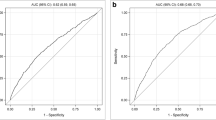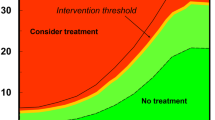Abstract
Objective
We examined a two-step case-finding strategy where the Cummings’ risk score (NEJM 1995) was applied in a population-based setting together with bone mineral density (BMD) measurements in order to validate its ability to identify women with high risk of hip fracture.
Methods
All Tromsø women aged between 65 and 74 were invited to the Tromsø Osteoporosis Study (TROST) together with a 5% random sample of women aged 75–84 years (n = 1410). All had forearm BMD measurements in 1994/95 and were followed for 5 years with respect to first hip fracture. A risk score was constructed matching the Cummings score as closely as possible.
Results
In all 759, 578 and 73 women had 0–2, 3–4 and 5+ risk factors, respectively. Women with 5+ risk factors had a 5-year hip fracture risk of 11% (95% confidence interval (CI) 3.7–18.2%). BMD screening applied to these women identified 74% of them as osteoporotic and 19% as osteopenic with, respectively, 5-year hip fracture risk of 13% and 7.1%.
Conclusion
In a population different from the one the score was generated in, this simple risk score identifies a group of women with high risk of hip fractures. With no additional BMD measurements, those high-risk women could benefit from early intervention measures.
Similar content being viewed by others
References
Black DM, Cummings SR, Melton LJ (1992) Appendicular bone mineral and a woman’s lifetime risk of hip fracture. J Bone Miner.Res.7:639–646
Cummings SR, Black DM, Nevitt MC, et al. (1993) Bone density at various sites for prediction of hip fractures. The Study of Osteoporotic Fractures Research Group [see comments]. Lancet 341:72–75
de-Laet CE, van-Hout BA, Burger H, et al.( 1998) Hip fracture prediction in elderly men and women: validation in the Rotterdam study. J.Bone Miner.Res 13(10):1587–1593
Wilkin TJ, Devendra D (2001) Bone densitometry is not a good predictor of hip fracture.[see comment]. BMJ 323(7316):795–797
van der Klift M, de Laet CD, Pols HA (2005) Assessment of fracture risk: who should be treated for osteoporosis?. Best Pract Res Clin Rheumatol 19(6):937–950
Nguyen TV, Center JR, Pocock NA, et al (2004) Limited utility of clinical indices for the prediction of symptomatic fracture risk in postmenopausal women. Osteoporos Int 15(1):49–55
Cadarette SM, McIsaac WJ, Hawker GA, et al. (2004) The validity of decision rules for selecting women with primary osteoporosis for bone mineral density testing. Osteoporos Int 15(5):361–366
Rud B, Jensen JE, Mosekilde L, et al. (2005) Performance of four clinical screening tools to select peri- and early postmenopausal women for dual X-ray absorptiometry. Osteoporos Int 16(7):764–772
Wehren LE, Siris ES (2004) Beyond bone mineral density: can existing clinical risk assessment instruments identify women at increased risk of osteoporosis? [see comment]. J Intern Med 256(5):375–380
Cummings SR, Nevitt MC, Browner WS, et al. (1995) Risk factors for hip fracture in white women. N Engl J Med 332:767–773
Taylor BC, Schreiner PJ, Stone KL, et al. (2004) Long-term prediction of incident hip fracture risk in elderly white women: study of osteoporotic fractures. J Am Geriatr Soc 52(9):1479–1486
Kanis JA (2002) Diagnosis of osteoporosis and assessment of fracture risk. [see comment]. Lancet 359(9321):1929–1936
Kanis JA, Borgstrom F, De Laet C, et al. (2005) Assessment of fracture risk. Osteoporos Int 16(6):581–589
Kanis JA, Black D, Cooper C, et al. (2002) A new approach to the development of assessment guidelines for osteoporosis. Osteoporos Int 13(7):527–536
Burger H, de Laet CE, Weel AE, et al. (1999) Added value of bone mineral density in hip fracture risk scores. Bone 25(3):369–374
Black DM, Steinbuch M, Palermo L, et al. (2001) An assessment tool for predicting fracture risk in postmenopausal women. Osteoporos Int 12(7):519–528
Leslie WD (2003) Contribution of clinical risk factors to bone density-based absolute fracture risk assessment in postmenopausal women. Osteoporos Int 14:334–338
Thompson PW (2000) A fracture risk profile using single-site bone density assessment and clinical risk factors. [erratum appears in J Clin Densitom 2004 Summer;7(2):253]. J Clin Densitom 3(1):73–77
Dargentmolina P, Favier F, Grandjean H, et al. (1996) Fall-related factors and risk of hip fracture: the EPIDOS prospective study. Lancet 348(9021):145–149
Dargent-Molina P, Douchin MN, Cormier C, et al. (2002) Use of clinical risk factors in elderly women with low bone mineral density to identify women at higher risk of hip fracture: The EPIDOS prospective study. Osteoporos Int 13(7):593–599
Miller PD, Barlas S, Brenneman SK, et al. (2004) An approach to identifying osteopenic women at increased short-term risk of fracture. [see comment]. Arch Intern Med 164(10):1113–1120
Eastell R, Reid DM, Compston J, et al. (2001) Secondary prevention of osteoporosis: when should a non-vertebral fracture be a trigger for action? Qjm 94(11):575–597
McGrother CW, Donaldson MM, Clayton D, et al. (2002) Evaluation of a hip fracture risk score for assessing elderly women: the Melton Osteoporotic Fracture (MOF) study. Osteoporos Int 13(1):89–96
Black DM, Cooper C (2000) Epidemiology of fractures and assessment of fracture risk. Clin Lab Med 20(3):439–453
Dargent-Molina P, Piault S, Breart G, et al. (2005) A triage strategy based on clinical risk factors for selecting elderly women for treatment or bone densitometry: the EPIDOS prospective study. Osteoporos Int 16(8):898–906
Berntsen GK, Fonnebo V, Tollan A, et al. (2001) Forearm bone mineral density by age in 7,620 men and women: the Tromso study, a population-based study. Am J Epidemiol 153(5):465–473
Joakimsen RM, Fonnebo V, Sogaard AJ, et al. (2001) The Tromso study: registration of fractures, how good are self-reports, a computerized radiographic register and a discharge register? Osteoporos Int 12(12):1001–1005
Faulkner KG (2005) The tale of the T-score: review and perspective. Osteoporos Int 16(4):347–352
Joakimsen RM (1999) Risk factors for non-vertebral fractures in middle-aged population (thesis). University of Tromsø, Tromsø
Vergouwe Y, Steyerberg EW, Eijkemans MJ, et al. (2005) Substantial effective sample sizes were required for external validation studies of predictive logistic regression models. J Clin Epidemiol 58(5):475–483
Cummings SR, Black D (1995) Bone mass measurements and risk of fracture in Caucasian women: a review of findings from prospective studies. Am J Med 98(2A):24S–28S
Marshall D, Johnell O, Wedel H (1996) Meta-analysis of how well measures of bone mineral density predict occurrence of osteoporotic fractures. BMJ 312(7041):1254–1259
Kern LM, Powe NR, Levine MA, et al. (2005) Association between screening for osteoporosis and the incidence of hip fracture.[see comment]. Ann Intern Med 142(3):173–81
Nelson HD, Helfand M, Woolf SH, et al. (2002) Screening for postmenopausal osteoporosis: a review of the evidence for the U.S. Preventive Services Task Force. [see comment] [summary for patients in Ann Intern Med 2002 Sep 17;137(6):I59; PMID: 12230384]. Ann Intern Med 137(6):529–541
Cummings SR, Bates D, Black DM (2002) Clinical use of bone densitometry: scientific review. [see comment][erratum appears in JAMA 2002 Dec 11;288(22):2825]. JAMA 288(15):1889–1897
Lacroix AZ, Buist DS, Brenneman SK, et al. (2005) Evaluation of three population-based strategies for fracture prevention: results of the osteoporosis population-based risk assessment (OPRA) trial. Med Care 43(3):293–302
Colon-Emeric CS, Pieper CF, Artz MB (2002) Can historical and functional risk factors be used to predict fractures in community-dwelling older adults? development and validation of a clinical tool. Osteoporos Int 13(12):955–961
The WHO Study Group (1994) Assessment of fracture risk and its application to screening for postmenopausal osteoporosis. World Health Organ Tech Rep Ser 843:1–129
Kanis JA, Johnell O, Black DM, et al. (2003) Effect of raloxifene on the risk of new vertebral fracture in postmenopausal women with osteopenia or osteoporosis: a reanalysis of the Multiple Outcomes of Raloxifene Evaluation trial. Bone 33(3):293–300
Quandt SA, Thompson DE, Schneider DL, et al. (2005) Effect of alendronate on vertebral fracture risk in women with bone mineral density T-scores of−1.6 to −2.5 at the femoral neck: the Fracture Intervention Trial. Mayo Clin Proc 80(3):343–349
Porthouse J, Birks YF, Torgerson DJ, et al. (2004) Risk factors for fracture in a UK population: a prospective cohort study. Qjm 97(9):569–574
Author information
Authors and Affiliations
Corresponding author
Electronic supplementary material
Rights and permissions
About this article
Cite this article
Ahmed, L.A., Schirmer, H., Fønnebø, V. et al. Validation of the Cummings’ risk score; how well does it identify women with high risk of hip fracture: The Tromsø Study. Eur J Epidemiol 21, 815–822 (2006). https://doi.org/10.1007/s10654-006-9072-3
Received:
Accepted:
Published:
Issue Date:
DOI: https://doi.org/10.1007/s10654-006-9072-3




